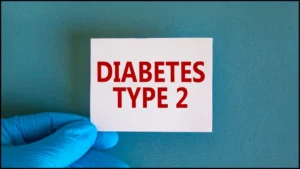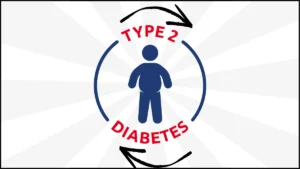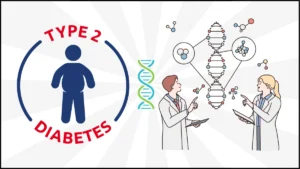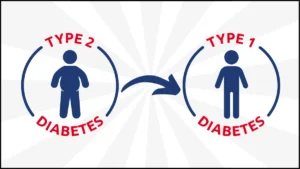Type 2 diabetes is more than just a blood sugar problem, it’s a condition that affects millions of lives worldwide. Whether you’ve been diagnosed, have a loved one facing it, or simply want to lower your risk, understanding this condition is crucial.
Many people wonder: Can type 2 diabetes be reversed? Is it genetic? Can it turn into type 1 diabetes? What does it mean for life expectancy?
These are important questions, and in this article, we’ll break them down in simple, easy-to-understand terms.
The good news? Type 2 diabetes isn’t a life sentence. With the right knowledge and lifestyle changes, you can take control of your health, prevent complications, and even put diabetes into remission.
Let’s dive in and explore everything you need to know about type 2 diabetes.
Table of Contents
What is Type 2 Diabetes?
Type 2 diabetes is a long-term condition that affects how the body processes sugar (glucose), which is the main source of energy for our cells.
The problem occurs when the body either doesn’t use insulin properly or doesn’t produce enough of it. Insulin is the hormone responsible for helping glucose move from the bloodstream into the cells. When insulin isn’t working correctly, glucose stays in the blood, causing high blood sugar levels (hyperglycemia).
Over time, high blood sugar can lead to various health problems.

What Happens in the Body?
- Insulin Resistance: The body’s cells become resistant to insulin, meaning they don’t respond well to it. As a result, glucose isn’t absorbed properly, leading to increased blood sugar levels.
- Inadequate Insulin Production: Over time, the pancreas may struggle to produce enough insulin to keep up with the body’s needs. This worsens the problem, making it harder to control blood sugar.
- Blood Sugar Spikes: When the body can’t regulate glucose levels effectively, blood sugar spikes occur. This can cause symptoms like increased thirst, frequent urination, fatigue, and blurry vision.
If type 2 diabetes is not managed, it can lead to serious complications such as:
- Heart Disease – High blood sugar damages blood vessels, increasing the risk of heart attacks and strokes. Over time, the arteries may become narrowed or clogged, leading to circulation issues.
- Nerve Damage (Neuropathy) – High sugar levels can harm nerves, leading to tingling, pain, or numbness, especially in the feet and hands. This can result in loss of sensation and increase the risk of injuries or infections.
- Kidney Disease – The kidneys work hard to filter excess sugar from the blood. Over time, this extra strain can lead to kidney failure or the need for dialysis.
- Eye Problems (Retinopathy) – Diabetes can damage the tiny blood vessels in the eyes, leading to blurred vision, cataracts, or even blindness if left untreated.
Who is at Risk?
Several factors can increase the risk of developing type 2 diabetes, including:
- Being overweight or obese – Excess body fat, especially around the abdomen, increases insulin resistance.
- Lack of physical activity – A sedentary lifestyle makes it harder for the body to use insulin efficiently.
- Unhealthy diet – A diet high in processed foods, sugary drinks, and refined carbohydrates can raise blood sugar levels.
- Family history – Having close relatives with type 2 diabetes increases the likelihood of developing the condition.
- Age – The risk increases with age, especially after 45, but younger people, including children, are also being diagnosed more frequently.
- Gestational diabetes – Women who had diabetes during pregnancy have a higher risk of developing type 2 diabetes later in life.
Unlike type 1 diabetes, which usually develops in childhood and is caused by an autoimmune response, type 2 diabetes often develops gradually over time. The good news? Type 2 diabetes can often be managed—and in some cases, even reversed with lifestyle changes.
Are you looking for best supplements to regulate and maintain your blood sugar levels, then check out the Shop by Smart Sugar control!
Can Type 2 Diabetes Be Reversed?
The good news? In many cases, type 2 diabetes can be reversed!
This doesn’t mean it’s completely cured (we will talk about this in the upcoming section), but it can be managed so well that blood sugar levels return to a healthy range without the need for medication.

How Does Reversal Work?
Reversing type 2 diabetes means bringing blood sugar levels back to normal without relying on diabetes medications.
This is often called diabetes remission and is possible through significant lifestyle changes that improve how the body processes insulin and glucose.
Steps to Reverse Type 2 Diabetes
- Losing Weight – Shedding even 5-10% of body weight can improve blood sugar control. Excess fat, especially around the abdomen, contributes to insulin resistance. Losing weight allows insulin to work more effectively and helps lower blood sugar levels.
- Healthy Eating – A well-balanced diet is key to reversing diabetes. Focus on:
- Whole grains (brown rice, quinoa, oats) instead of refined carbs.
- Lean proteins (chicken, fish, tofu) to keep blood sugar stable.
- Healthy fats (avocados, nuts, olive oil) that support metabolism.
- Fiber-rich vegetables (broccoli, spinach, carrots) to slow sugar absorption.
- Cutting out processed foods and sugary drinks to prevent blood sugar spikes.
- Regular Exercise – Physical activity increases insulin sensitivity, meaning the body can use glucose more efficiently. Recommended activities include:
- Walking for at least 30 minutes a day.
- Strength training to build muscle and improve metabolism.
- Aerobic exercises like cycling or swimming to enhance heart health and blood sugar regulation.
- Intermittent Fasting & Meal Timing – Some studies suggest that time-restricted eating (e.g., fasting for 14-16 hours overnight) can help regulate insulin levels and support diabetes reversal.
- Managing Stress & Sleep – Chronic stress raises cortisol levels, which can increase blood sugar. Getting enough sleep (7-9 hours per night) and practicing relaxation techniques like yoga, meditation, or deep breathing can improve overall health.
- Medication & Medical Supervision – Some people may need temporary medication support while making lifestyle changes. Always work with a doctor to adjust medication as needed when making big lifestyle improvements.
Who Can Reverse Type 2 Diabetes?
Not everyone will be able to reverse their diabetes, but those who are in the early stages of the disease, actively manage their weight, and commit to lifestyle changes have the best chances. Factors that improve the likelihood of reversal include:
- A recent diagnosis (within 5 years).
- No history of needing insulin.
- Significant weight loss.
- Consistent blood sugar control through diet and exercise.
For some, diabetes reversal might not be permanent. If old habits return, blood sugar levels may rise again, which is why ongoing healthy habits are essential.
Is Type 2 Diabetes Genetic or Hereditary?
Yes, type 2 diabetes has a genetic component.
If your parents or close relatives have it, you have a higher risk of developing it. However, genes alone don’t determine your fate.

How Genetics Influence Type 2 Diabetes
- Family History – If one or both parents have type 2 diabetes, the chances of developing it increase significantly.
- Multiple Genes Involved – Unlike some diseases caused by a single gene mutation, type 2 diabetes is influenced by multiple genetic factors that affect how the body processes insulin and glucose.
- Interaction with Lifestyle – Genetics may make someone more prone to diabetes, but lifestyle choices (diet, exercise, and weight management) play a much bigger role in whether the disease develops.
- Ethnicity and Risk – Certain ethnic groups, such as African American, Hispanic, Native American, and Asian populations, have a higher genetic predisposition to type 2 diabetes.
Preventing Type 2 Diabetes Despite Genetics
Even if diabetes runs in your family, you can significantly lower your risk by:
- Maintaining a healthy weight.
- Eating a balanced diet rich in whole foods.
- Staying physically active.
- Managing stress and getting quality sleep.
Genes may load the gun, but lifestyle pulls the trigger. Making healthy choices early can prevent or delay type 2 diabetes.
Are you looking for best supplements to regulate and maintain your blood sugar levels, then check out the Shop by Smart Sugar control!
Can Type 2 Diabetes Turn Into Type 1 Diabetes?
One of the most common questions about diabetes is whether type 2 diabetes can turn into type 1 diabetes. The short answer is no these are two distinct conditions with different causes and treatments. However, some factors can lead to confusion or misdiagnosis.

Type 1 diabetes is an autoimmune disease where the body’s immune system mistakenly attacks insulin-producing cells in the pancreas, leading to little or no insulin production. In contrast, type 2 diabetes is primarily caused by insulin resistance and gradual insulin production decline.
In rare cases, a person with type 2 diabetes might develop severe insulin dependence over time, making it seem like they have type 1 diabetes.
This is sometimes referred to as latent autoimmune diabetes in adults (LADA) or pancreatic burnout, but it is not the same as type 1 diabetes.
Understanding the Difference
- Cause: Type 1 diabetes is an autoimmune disease where the immune system attacks insulin-producing cells in the pancreas, leading to little or no insulin production. Type 2 diabetes develops due to insulin resistance and a gradual decline in insulin production over time.
- Age of Onset: Type 1 diabetes typically starts in childhood or adolescence, while type 2 diabetes usually develops in adulthood, though more children are now being diagnosed due to obesity.
- Treatment: Type 1 diabetes requires insulin therapy for survival. Type 2 diabetes is often managed with diet, exercise, oral medications, and sometimes insulin if needed.
What Can Happen Instead?
Although type 2 diabetes does not become type 1 diabetes, certain conditions can make it seem like it has:
- LADA (Latent Autoimmune Diabetes in Adults): Sometimes called type 1.5 diabetes, LADA is a slow-progressing form of autoimmune diabetes that initially looks like type 2 but eventually requires insulin.
- Severe Beta-Cell Failure: If type 2 diabetes is not well-managed for many years, the pancreas may stop producing insulin altogether, requiring insulin therapy similar to type 1 diabetes.
Misdiagnosis: Some adults diagnosed with type 2 diabetes may actually have LADA, leading to a shift in treatment over time.
Preventing Beta-Cell Failure
Even though type 2 diabetes won’t turn into type 1, poor management can lead to insulin dependence. To keep your pancreas functioning well:
- Maintain healthy blood sugar levels through diet and exercise.
- Avoid high-sugar, high-carb processed foods.
- Monitor blood sugar levels regularly and adjust treatment as needed.
- Work with a doctor to ensure the right diagnosis and treatment plan.
Understanding the differences between type 1 and type 2 diabetes helps ensure the right treatment and management strategies are in place.
Type 2 Diabetes Life Expectancy
Having type 2 diabetes does not mean you cannot live a long and healthy life. However, poorly managed diabetes can reduce life expectancy due to complications.

Factors That Influence Life Expectancy
- Blood Sugar Control: Keeping blood sugar levels in a healthy range helps prevent long-term complications.
- Heart Health: Managing blood pressure and cholesterol reduces the risk of heart disease and stroke.
- Weight Management: Maintaining a healthy weight improves insulin sensitivity and overall health.
- Physical Activity: Regular exercise helps regulate blood sugar and supports heart health.
- Medication & Monitoring: Taking prescribed medications and regularly checking blood sugar levels ensure proper management.
How to Improve Life Expectancy?
- Eat a balanced diet: Focus on whole foods, lean proteins, fiber, and healthy fats.
- Stay active: Aim for at least 150 minutes of moderate exercise per week.
- Monitor blood sugar: Regular checks help prevent dangerous highs and lows.
- Manage stress: High stress levels can negatively impact blood sugar.
- Get regular check-ups: Early detection of complications can prevent serious issues.
By adopting a healthy lifestyle and managing diabetes properly, many people with type 2 diabetes live long, fulfilling lives.
Is Type 2 Diabetes Curable?
The question of whether type 2 diabetes is curable is a common one.
The simple answer is that while there is currently no permanent cure for type 2 diabetes, it can be put into remission with the right lifestyle changes and medical management.
Understanding Diabetes Remission
Diabetes remission means that blood sugar levels return to a normal range without the need for diabetes medications. However, remission does not mean the disease is completely gone—it can return if healthy habits are not maintained.
There are three types of diabetes remission:
- Partial Remission: Blood sugar levels remain below the diabetes threshold for at least one year without diabetes medication, but not entirely within the normal range.
- Complete Remission: Blood sugar levels stay in the normal range for at least a year without any diabetes medications.
- Prolonged Remission: Blood sugar levels remain normal for five or more years without the need for medications.
It’s important to note that remission is not the same as a cure. The risk of diabetes returning remains if an individual does not continue with healthy lifestyle habits.
How Can Type 2 Diabetes Go Into Remission?
- Weight Loss: Losing excess weight, particularly around the abdomen, can significantly improve insulin sensitivity and reduce blood sugar levels.
- Healthy Diet: A diet rich in whole foods, vegetables, lean proteins, and healthy fats can help regulate glucose levels.
- Regular Exercise: Physical activity helps the body use insulin more effectively and lowers blood sugar naturally.
- Bariatric Surgery: For some people with severe obesity, weight-loss surgery has been shown to induce long-term diabetes remission.
- Early Intervention: The earlier type 2 diabetes is diagnosed and managed, the better the chances of achieving remission.
Can Diabetes Come Back?
Yes, even if someone achieves remission, type 2 diabetes can return if they revert to unhealthy lifestyle habits. Factors that can lead to diabetes returning include:
- Weight gain – Excess weight, especially around the abdomen, increases insulin resistance and can lead to rising blood sugar levels again.
- Poor dietary choices – A diet high in processed foods, refined carbs, and sugary drinks can contribute to blood sugar spikes and insulin resistance.
- Lack of physical activity – Being sedentary reduces the body’s ability to regulate blood sugar effectively.
- Chronic stress and poor sleep – Both stress and lack of sleep can disrupt hormone levels, leading to increased insulin resistance and higher blood sugar levels.
- Aging – As people age, their metabolism slows down, and insulin resistance may increase over time.
While there is no permanent cure, many people successfully control and even reverse type 2 diabetes with sustained lifestyle changes. The key is long-term commitment to a healthy way of living. Even after achieving remission, it’s important to maintain healthy habits to prevent diabetes from returning.
Are you looking for best supplements to regulate and maintain your blood sugar levels, then check out the Shop by Smart Sugar control!d
Final Thoughts
Type 2 diabetes is a manageable condition, but it requires commitment to a healthier lifestyle. While there is no permanent cure, many people successfully put their diabetes into remission and significantly improve their quality of life.
The key is early diagnosis, consistent monitoring, and proactive steps such as maintaining a balanced diet, staying physically active, and managing weight.
If you or a loved one has type 2 diabetes, remember that small, consistent efforts can make a big difference.
Whether it’s making better food choices, increasing daily movement, or keeping up with doctor’s visits, every step you take towards a healthier lifestyle will help in the long run.
Your health is in your hands, and with the right approach, you can lead a full and active life despite having diabetes. Stay informed, stay motivated, and take charge of your well-being! Have questions?
Drop them in the comments we’re here to help!
References
This article is based on general knowledge, medical research, and reputable health sources such as:
- American Diabetes Association (ADA) – diabetes.org
- Centers for Disease Control and Prevention (CDC) – cdc.gov/diabetes
- National Institute of Diabetes and Digestive and Kidney Diseases (NIDDK) – niddk.nih.gov
- Mayo Clinic – mayoclinic.org
- World Health Organization (WHO) – who.int
